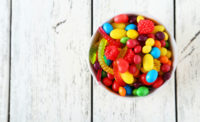Big Candy announces partnership with nonprofit to reduce calories in individually-wrapped products
Eight major producers to make products with 200 calories or fewer, update packaging.

Eight major candy manufacturers have committed to reducing calories in their individually-wrapped products and updating front-of-pack nutrition labels as part of an ongoing effort to offer consumers greater choice and transparency.
By 2022, half of the the individually-wrapped products produced by Mars Chocolate, Wrigley, Nestlé USA, Ferrero, Lindt, Ghirardelli, Russell Stover, and Ferrara Candy Co. will have 200 calories or fewer. Furthermore, calorie information will be printed on the front of 90 percent of best-selling treats made by those companies.
The manufacturers, along with the nonprofit Partnership for a Healthier America (PHA), announced the commitments last Thursday at the PHA’s Building a Healthier Future Summit. PHA, in conjunction with research organization Hudson Institute, will also be responsible for independent, third-party progress reporting.
John Downs, president and ceo of the National Confectioners Association, said the organization is “proud” to partner with the PHA and continue educating consumers on making informed choices.
“Over the next five years, the participating chocolate and candy companies will help consumers better understand the unique role that confections can play in a happy, balanced lifestyle,” Downs said. “As we focus and leverage the companies’ expertise in marketing, innovation, and distribution, our goal is to reinforce for consumers that chocolate and candy are treats.”
The NCA said more than 60 percent of the companies’ individually-wrapped products contain fewer than 250 calories per pack, noting consumers are likely to see more options in smaller sizes.
“Chocolate and candy have always been a treat, and this is a big commitment by the participating companies to keep it that way,” Downs said.
Pointing to its previous efforts to replace king-sized items with smaller portion sizes and report calorie measurements on packaging of its confections, Mars Chocolate has pledged more than $200 million to continue meeting the PHA commitments and help others in the industry do the same.
“Over the past decade, we have been laser-focused on continuously pushing ourselves and our peers to offer consumers more choice and transparency while keeping the same great tastes and experiences our fans love,” said Tracey Massey, president of Mars Chocolate North America. “By joining forces with PHA and other leading confectionery manufacturers to create even deeper commitments, we are taking an important step forward to transform the entire industry so we can evolve to meet and exceed the demands of today’s consumers.”
Two weeks ago, Hershey also announced plans to update front-of-pack calorie labels and make more of its standard- and king-sized items with 200 calories or fewer. The company made no mention of working with PHA.
“Consumers are at the heart of all that we do, and we have been at the forefront of providing the choice and transparency we want,” says CEO and President Michele Buck. “We aim to delight our consumers, and these steps will provide an even wider range of portion options and clear information to help them select treats that fit their lifestyle.”
Hershey said 31 percent of its portfolio of individually-wrapped standard- and king-sized items already contain 200 calories or fewer, but the Pennsylvania-based confectionery giant wants half of those items to meet that benchmark by 2022. The company plans to achieve it by reformulating products, creating new, shareable items, and adjusting the size of other items.
These initiatives come almost a year after the U.S. Food and Drug Administration released a new nutrition label that requires manufacturers to list added sugar content, likely stimulating them to reformulate products and package sizes to become more appealing to consumers concerned about sugar intake ahead of the July 2018 compliance deadline.
At least two major manufacturers have committed to reducing sugar content. Nestlé vowed to cut sugar by an average of 10 percent from 2013 levels by 2016. PepsiCo also announced last year that at least two-thirds of its global beverage portfolio volume will have 100 calories or fewer from added sugars per 12-oz. serving by 2025.
Looking for a reprint of this article?
From high-res PDFs to custom plaques, order your copy today!







